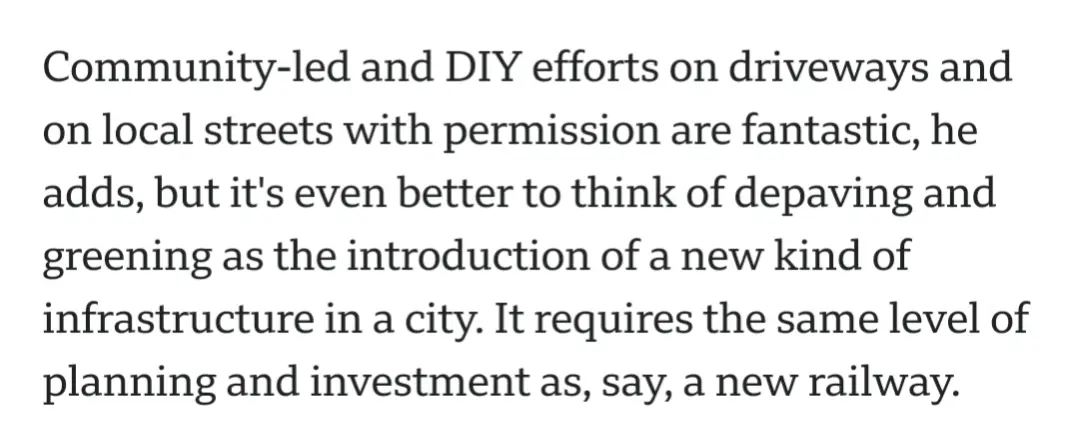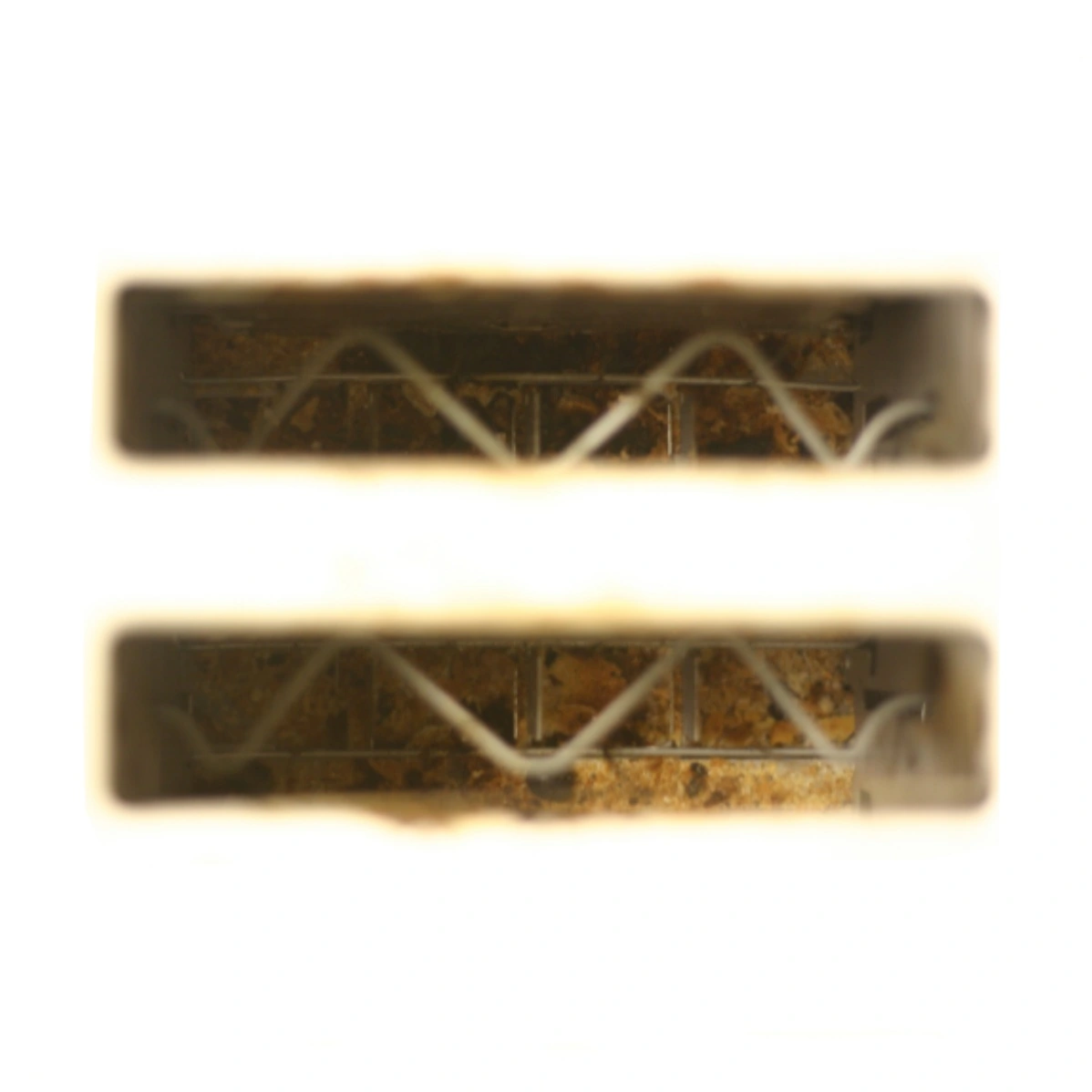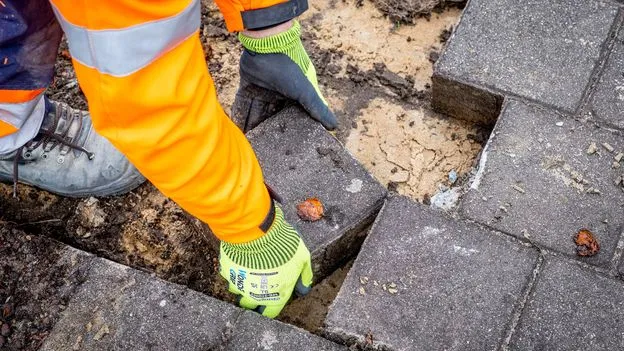- cross-posted to:
- upliftingnews@lemmy.world
- urbanism
- geography@mander.xyz
- cross-posted to:
- upliftingnews@lemmy.world
- urbanism
- geography@mander.xyz
This is a really good idea. That said, depaving is not easy. Anything paved will have compaction issues and lack any sort of organic matter. On top of that you need to check for contaminants.
The crux of getting the movement going is this:

Without planning and private land owner buy in it’s hard to get rolling.
E: someone ask me how I would go about this all - fair warning I’m a mega nerd on this stuff
Oooh, I’m interested. How would you go about this all?? I love reading people nerd out on things they’re passionate about, and I’m really interested in this topic!
@ counselingtechie; YungOnions@sh.it.just.works - this is also to address your interest. Buckle up, because this is going to be relatively long.
Key Topics
- Community and land owner buy-in
- Site preparation, planning, and soil considerations
- Sourcing of materials, and equipment
- Revegetation
- Maintenance
Communities and land owner buy in
As I’ve pointed out in my earlier posts, depaving goes pretty much nowhere unless you’ve got community and land owner buy-in. It’s great that we want to re-green parts of our sprawling cities, but without some funding and permission to push this initiative, we’re pretty much dead in the water. You can’t go out under cover of darkness, and rip up a parking lot (tempting as that might be), for instance.
The first place I would start would be to get in touch with conservation based NGOs. There are things like local land trusts, Ducks Unlimited etc. that all have conservation based mandates, and have access to grants, that your average group of green thumbs will not have. On top of that, they already likely have connections to major players, such as local governments. I will point out, that they may be more interested in saving land that’s not already disturbed. Fair enough - reclamation and remediation are labour intensive and costly.
In some jurisdictions, I believe there are tax breaks for land owners that created ‘public good’ (art features, host businesses that offer public services, like coffee shops), thus my approach would be to first figure out who I needed to talk to in local government, try to align my vision of a green urban landscape with existing initiatives (e.g., communities in bloom, other funding that might align with this objective). Once I had people not standing in my way, I would start looking for ideal pieces of land to try this on. It would also be good to partner with a trucking or landscaping company to help deal with wastes and address soil issues which I’ll touch on later.
Site preparation and planning
this leads us to ‘where’ we are going to do this activity. We’d want some place that ideally could tie in to existing parks or green-spaces, or find a spot that may be an island in the middle of a bunch of sprawl that people would want to go to. The general approach is to get into a situation where our group does not own the land, but stewards it to the benefit of a company who’s looking to project a ‘green image’. This way, we don’t have to pay for the land, and the proponent gets something out of the land that’s not being used to its fullest potential - win, win. We also don’t want to have a bunch of random shit to deal with. I would be targeting lesser-used downtown parking lots (gravel ones, ideally).
Ok, so we have a paved or gravel lot (parking or otherwise) we potentially want to restore. First step is to do a background check for likely sources of contamination. Does the land title indicate this was a gas station (for example) at one point? then we don’t want to touch it. Where possible, we want to completely avoid hydrocarbons or other shit, because we’ll have to dig it out later.
Assuming we’re ok, we still want to check with sampling. You’d want a minimum 3 composite samples in the 0-20 cm and 20-50 cm depths. Conduct one-calls (ground disturbance screening) first. the 0 to 50 cm is typically the rooting zone, and going deeper is going to be tough. Composites give you a good idea of the most likely conditions you’ll encounter, but you do lose the identification of local hot spots. Since we’re on a budget, composite is the way to go. I’d run these samples for hydrocarbons, metals, and salinity. In the case of paved lots, you’re more prone to not knowing what’s there. Once we get the samples, compare them to relevant guidelines. So long as things aren’t going to kill our veg, or bioaccumulate into veg and cause a risk to someone who decides to eat leaves, we’re good. If we do have a contaminated site, the contamination has to be dug out and trucked to a landfill, with clean fill brought in. This is not really feasible for us, though, so I emphasize careful preliminary screening beforehand.
At some point, you’ll also need to get in touch with a landscape architect or come up with some sort of vision for the finished area. Will you have walking paths? Gardens? Bird boxes? all of this stuff and its placement needs to be considered. You should also consider where any surface runoff is going to go.
Sourcing of materials, and equipment
Congratulations! you found yourself a clean site! Now what? If it’s paved, then we depave. Get volunteers to rip up stones if it can be done manually. Most likely, however, at this point you’ll have to know someone with an excavator (and jackhammer attachment) to break shit up, dig it up, and haul it off. Your subsoil is likely compacted; check it with one of these if you have access to it; conversely, just check with a piece of rebar or such. If it requires a bunch of effort to sink the probe in, then it’s compacted and needs to be rototilled.
Bring your rototiller (or guy with a excavator) in an rip the shit out of the subsoil. You want nice clumpy aggregates, smaller than the size of your head. No bigger than fist sized, ideally.
Next, if you can, bring in a source of organic matter. Good places to check are mushroom farms (spent mushroom compost), or local recycle depots (sometimes they take green wastes). Rototill that stuff in. If nothing’s available, then you need to adjust what you’d plant.
Revegetation
Assuming you don’t have organic matter, you’ll want disturbance specialist species. Alders are fantastic disturbance specialists. They fix nitrogen, grow like weeds, and help anchor down soils. They also drop a lot of leaves, so they can act as a source of organic matter input. They are also really, really easy to collect and spread from seed. Willows are pretty good, too, at colonizing. You can also use reclamation mixes if you’re targeting grassy ecosystems. Fireweed is a fantastic (and beautiful) pioneer species to fill in voids and prevent the colonization of undesirables (looking at you, thistle). You can use a mulch layer too (no thicker than 2 cm) to help choke some crap out.
during this process, you’ll want to know what occurs in disturbed natural areas, and try and mimic that the best that you can. I talk about woody spp. above, because that’s what I’m the most familiar with. Your reveg prescription will ultimately depend on your targeted ecosystem and land use. Have a vision, set measurable goals to achieve this vision. Execute the steps needed to get you there.
Maintenance
You may very well have an intense maintenance period during the first growing season. You want things to establish and not die off. Water if you can. Watch for invasive/weedy species. If you didn’t plant it, hand pull it. The benefits of conducting maintenance need to be weighed against the impact (trampling) of conducting it, but be aggressive with weeds. Year 2, you’ll still be busy on weed detail, but you shouldn’t have to water.
As you can see, it’s not an easy thing to reclaim a site. There’s a lot to consider and a lot of effort required.
Fantastic! Thank you so much. I really enjoyed reading that and learning more. There’s more involved than I would have first thought! I appreciate you sharing this with us :)
No problem. I’d have written more, time permitting, but I’m flat out otherwise, and who actually wants a novel?
deleted by creator
Woohoo! There’s no rush at all, by the way. I’ll be happy to read it whenever you happen to get to it!
deleted by creator
That last point about investment is key. This is a great idea, but without continuous maintenance the risk is that any planted areas get overgrown, damaged etc. Still a great idea, though and I’d still prefer to see some weeds and grass than more tarmac, tbh.
continuous maintenance
Not necessarily. If you get your revegetation prescription and seeding/planting rate right, you can be maintenance free relatively soon, with ‘on-demand’ maintenance required only if you get a bunch of noxious weeds starting to creep in.
True!
I shall be the one to open the jar, for I am curious.
We’ve done this to a point in Montreal (parts of alleyways that were deemed unnecessary were de-paved, and small plants planted there. We don’t grow food there, but it looks nice, reduces traffic in alleyways and should help have less paved surfaces for heat in hot summer days.
Depaving the way to a bright future, love it.




